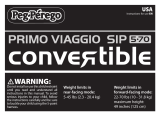
DANGER TO LIFE!
NEVER position the child seat backwards on a vehicle
seat that is equipped with an airbag.
NEVER position the child seat forwards on a vehicle
seat with an airbag, unless the manufacturer confi rms
its safety.
Do NOT use the child seat on vehicle seats that are
positioned sideways or backwards.
DO NOT USE ANY underlay, such as pillows or coats,
in order to raise the child seat on the vehicle seat. In the
case of an accident, the harnesses of your child seat
and the car seat belts would not protect your child in the
best possible manner.
Do NOT use the child seat at home. It has not been
designed for household use and should only be used in
your car.
Do NOT attempt to dismantle, modify or install parts into
the child seat or modify its harnesses or the belts in your
car or use it other than in the prescribed manner. The
offi cial approval is no longer value if modifi cations have
been made.
You are
NOT permitted to make any modifi cations to the
child seat, this is the manufacturer's responsibility.
NEVER leave your children alone in the car, not even for
a short time.
DO NOT leave any loose objects, such as luggage
or books, in the back of the car. Loose items must be
secured, as they fl y around in the case of a sudden
braking manoeuvre and could cause serious injuries.
Large, heavy, loose objects pose a particular risk.
DO NOT leave folded up car seats unlocked. In the case
of a sudden braking manoeuvre, a loose seat could
seriously injure your child.
Do NOT allow your children to play with or adjust their
child seat.
KEEP these operating instructions in an easily
accessible place.
COVER the child seat when your car is left in direct
sunlight. Buckles can become hot in sunshine and the
cover could bleach out.
MAKE sure that the child seat is not trapped by a
folding seat or the car door.
MAKE sure that the harnesses are adjusted according
to your child's clothing prior to the journey – if the
harnesses fi t with winter clothing, they may be too loose
with summer clothing.
If the child is not being used, KEEP IT IN A SAFE
PLACE. Do not place any heavy items on the child
seat and do not store it near heat sources or in direct
sunlight.
ALWAYS SECURE the child seat, even if it is not being
used by your child.
MAKE SURE that all persons in the vehicle are wearing
their seatbelts.
Although Britax-Römer pays attention to child car seats
coming into contact with car seats during development,
Britax-Römer is not liable for any damage to car seats
or seatbelts.
IMPORTANT:
Use with backward positioning
The child seat MUST always be used with a lap belt and
diagonal belt (approved according to UN/ECE Directive
No. 16 or relevant standards).
Use with forward positioning
The child seat MUST always be used with a lap belt and
diagonal belt (approved according to UN/ECE Directive
No. 16 or relevant standards).
Warning
9-25 kg group 1-2 (approx. 9 months – 6 years)
Diagonal
Pelvis
Pelvis
Diagonal






















